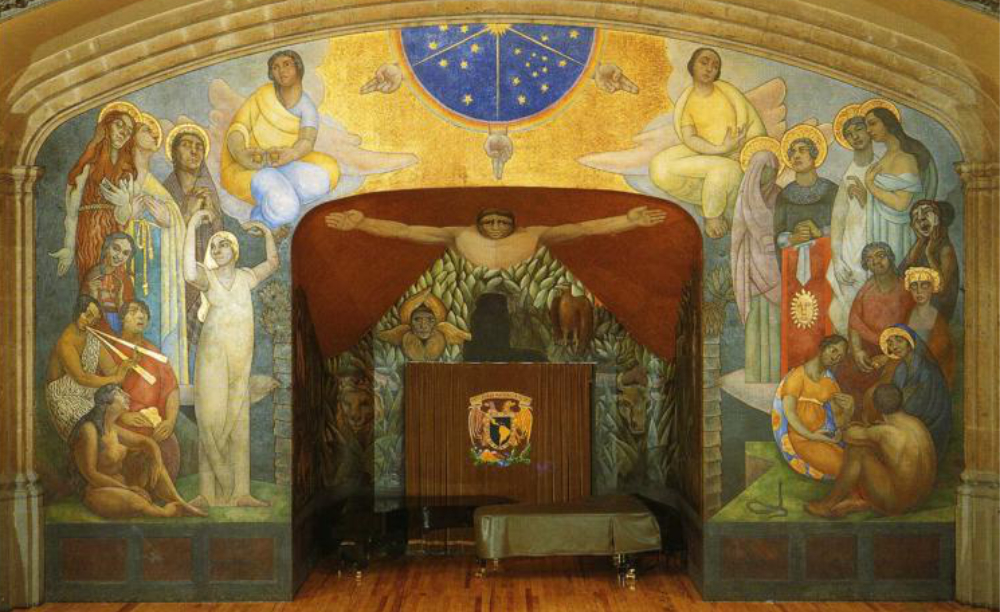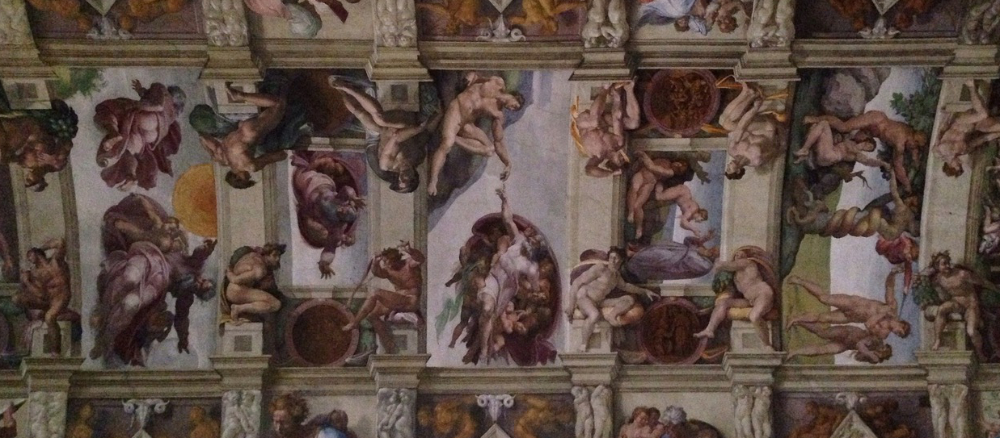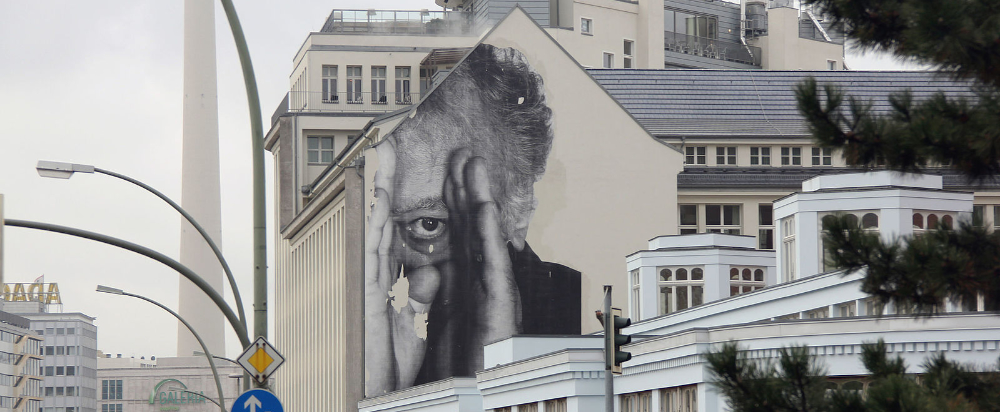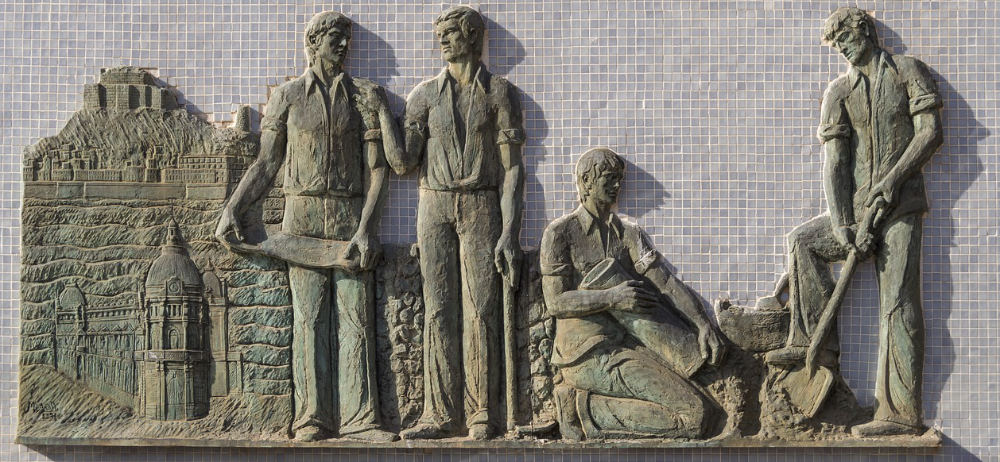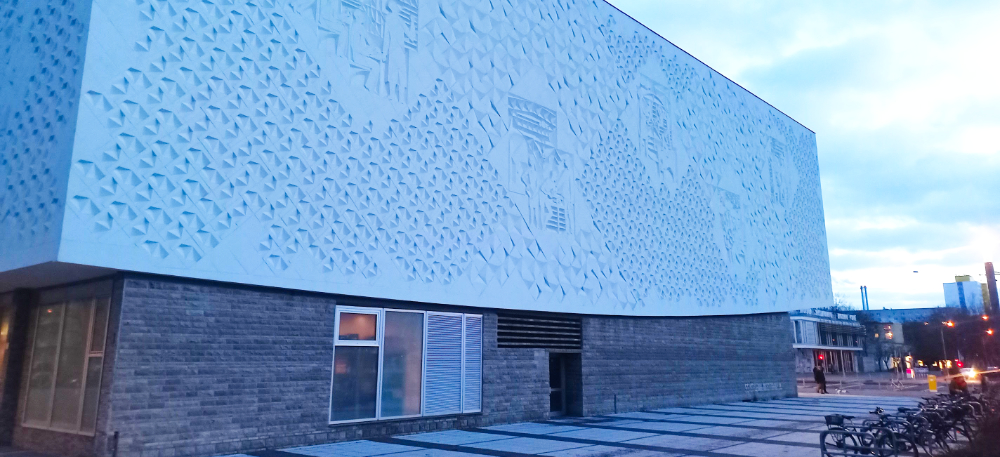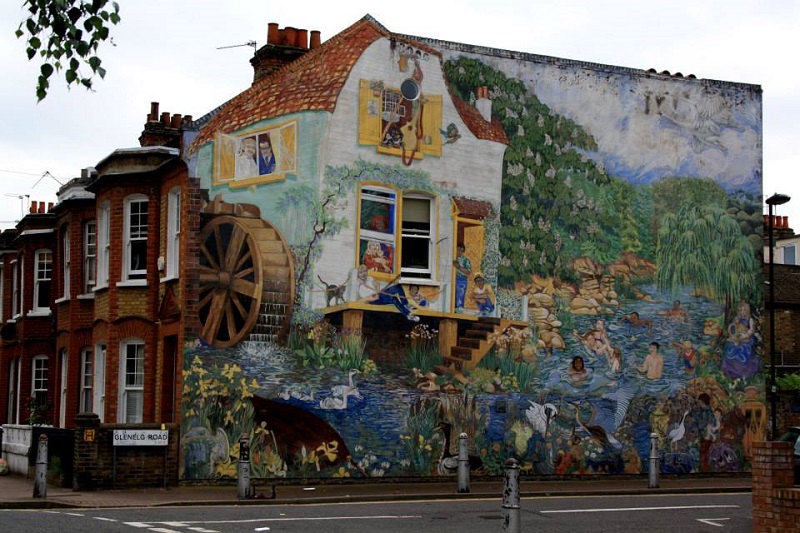Different types of murals
Contents |
[edit] Introducing murals in their different forms
Mural refers to a large graphic picture or image applied the wall, ceiling or floor of a room or the external facade of a building. Murals usually cover the whole of the surface area and may be installed for decoration, celebration or to impact the space through illusion often by request, sometimes murals, usually external, might be installed without permission in protest in humour or as a socio-political statement, in some cases murals are commissioned for advertising.
[edit] Advertising murals
Up until around the 1980s most forms of large scale advertising were painted, perhaps highlighted using lighting, these murals and billboards today are most commonly printed or created using multi media projection, screens, LEDs and so on. In many cities the faded remnants of early text and image advertisements painted directly on walls can be seen. Whilst hand painted billboards are a rare, they to continue to be produced in some areas, such as the Kino International in Berlin. Through the increased popularity of graffiti, street and urban art from around the 90s there has actually been a gradual increase in the use of spray painted murals across many cities, seen as connecting with elements of youth culture.
[edit] Commemorative murals
A mural was unveiled in July 2024 at Whitechapel Fire Station commemorating two London firefighters who lost their lives responding to a fire in 2004. The Firefighters Billy Faust and Adam Meere, Whitechapel Red Watch, were among fifty firefighters who attended a fire in Bethnal Green on 20 July 2004. Upon entering the building as a pair wearing Breathing Apparatus, they became trapped in the building’s basement following an explosion. Fellow firefighters at the scene immediately began to carry out an operation to reach Billy and Adam, who were rescued with severe injuries. Sadly, both passed away shortly after arriving at hospital. Adam, aged 27 at the time of his death, had only qualified as a firefighter three months earlier. Billy, aged 36, had served at Whitechapel Fire Station for seven years.
Designed by local artist David Speed, in a distinctive style that incorporates neon paintings in bold fluorescent colours, the mural stands prominently on the side the station, visible to the public travelling along Commercial Road. David was approached to paint the mural by Firefighter Carl Taylor, Whitechapel Blue Watch, who had seen the artists work at an exhibition.
Retired Station Officer Jon Scott, who served with Billy and Adam, said :“Losing Billy and Adam in 2004 was an incredibly difficult time for everybody at Whitechapel and surrounding stations and remains so to this day. We've never forgotten them, but through this mural and hard work of artist David Speed, their names have been introduced to a whole new audience with this mural, ensuring their memory never dies.”
Richard Tapp, Borough Commander for Tower Hamlets said: “It’s incredibly important for us in Tower Hamlets to remember Billy and Adam, and I’m proud that Whitechapel Fire Station will help achieve that with this memorial. David’s mural is an incredible addition to the station that honours two dedicated firefighters, that also fits with the spirit and culture of the borough.”
London Fire Commissioner Andy Roe said: “Twenty years ago, Billy and Adam's families, friends and colleagues experienced unimaginable pain with their loss. We know that firefighting is a dangerous job, but that does not make the loss of any firefighter easier. I’m grateful we now have this mural in their memory, and that people from across the Brigade have joined with Adam and Billy’s families to unveil it. It’s important for us as an organisation to remember, and for us to work hard in ensuring firefighters are as safe as possible when responding to emergencies.” (image from the London Fire Brigade)
[edit] Encaustic murals
Encaustic painting uses hot beeswax mixed with pigments and clay to create a deep layered effect with a hard surface, as such it was occasionally used to create internal murals by various artists. Diego River, later associated with the Mexican muralists, used this technique in one of his first murals painted in 1922, in the Simón Bolívar Amphitheatre of the Antiguo Colegio de San Ildefonso, Mexico City. The mural is called The Creation and depicts the creation of the Mexican people, with man emerging from the tree of life (image courtesy of Joaquín Martínez from Campeche, Mexico under CC license).
[edit] Fresco murals
Fresco refers to a mural technique using dry powder pigments and water applied to wet freshly laid lime plaster, rather than a surface finish the image becomes integral with the wall finish. One of the most famous frescos was commissioned by Pope Julius II and painted over a four year period by Michelangelo from 1508 who became ill during the process. The ceiling of the Sistine Chapel depicts events and characters from the Old Testament, located Vatican City it is celebrated around the world and a UNESCO World Heritage Site. Other frescos (or frescoes) were made as early as 1500 BC, with many examples in Knossos in Crete. The technique was developed in Italy during the thirteenth century, and became popular during the Renaissance By the mid-16th century oil painting had become more popular than fresco painting, as there are fewer technical challenges, it is possible to achieve a gloss, translucent finish, and the painting can be moved.
See also the article Frescos.
[edit] Graffiti art murals
Graffiti exploded through the 1980s mainly with tags and graphics, in most cases these individual pieces might not be considered so much as mural but referred to more generally as street art. The use of spray paint and introduction of stencils in the 1990s allowed the genre to expand to larger graphics, many of which remained smaller individual piece however a number are now referred to as murals. In particular some works of the, as yet unidentified graffiti artist known as Banksy. These three examples are significant because although all illegally created, the changing reactions to them over the years is significant. The first, located Newman Street in London, depicts a young child painting a message on the wall of a building used by the Royal Mail which happened to have CCTV cameras opposite was painted over by Westminster council in 2008. The second painted on a Council office building in Bristol went to a public organised by the council to decide its fate the public voted 98% in favour of keeping the work, so it was retained. The final example was on a building that is now demolished but the contractors intend to restore the work from the building material. (Images courtesy of CC license in order by Oxyman, Adrian Pingstone and Jay Galvin)
See also the article A brief history of graffiti and the built environment.
[edit] Lüftlmalerei murals.
Lüftlmalerei (or airy painting in literal English) is another term referring to informal Trompe l’oeil murals, created by local craftspersons to decorated individual homes in Southern Germany and Austria from around the 1700's - the tradition continues today.
[edit] Mosaic murals
Mosaic tiles are extremely hard wearing and long lasting and can be installed by a wider variety of craftspersons, with guidance as such mosaic murals have for some time been favoured as mural materials. The Buzludzha Monumental Mosaic in Bulgaria was designed by Guéorguy Stoilov, in 1981 to reflect the secret meetings of the Bulgarian social democratic parties and depicts various scenes reflecting the construction of a socialist society. The mosaic is a main feature of the futurist monument by the same name, it was abandoned in 1991, has stood decaying for many years but is celebrated architecturally. In 2018 it was named one of the seven most endangered heritage sites in Europe, by heritage organisation Europa Nostra and since then there have been various programmes to raise funds to save the building from gradual disrepair. Other well known mosaic murals include Setanta Mosaic Mural by Desmond Kinney’s (1974) in Dublin, the Chartist Mosaic Mural in Wales, commemorating the Newport Rising by Kenneth Budd (1839) and the Soviet Mosaic Mural in Georgia.

[edit] Photographic murals
Photgraphic murals in general are confined to interior spaces and certain artists sucg as Gilber and George use large scale photographic collages to create mural works. The phograph medium, in particular using photocopies of photographs, is also a common medium in the creation of small scale street art works.
One particular street artist know for extreemly large scale photography based murals using photocopy paper and glue is the artist JR. Here a smaller piece in the city of Berlin (image courtesy of OTFW, Berlin cc licence) but other projects have covered much larger areas, creating murals on the facades of buildings of a small hillside community, often images of the community inhabitants ( for further information visit https://www.jr-art.net/projects)
[edit] Protest murals.
Protest murals come in many different forms but are created as a means of expression usually against a decision or social event in protest. The example below is the Nuclear Dawn a mural on the wall of a Victorian-era building in Brixton, South London. It was painted in 1981, by Brian Barnes with the help of Dale McCrea and twenty other residents of the Carlton Mansions which at the time was a thriving co-operative housing community. It was initially funded by the Arts Council, the Gulbenkian Foundation, the Greater London Arts Association, and a £2,000 grant from Lambeth Council's Inner City Partnership Fund. In 2017 it was defaced with tags and graffiti, the artwork was restored in 2021 as part of a redevelopment scheme. The artwork provides a visceral representation of a time of escalating international tensions, when a nuclear strike felt a real possibility in 2017 and perhaps some equal resonance in 2024. see also Nuclear Dawn mural, Brixton.
[edit] Relief murals
Relief murals, carved murals, stone murals and so on depict images from the shadows created by the relief of its surface. They may also be referred to as wall sculptures or just reliefs as well as pictographs, referencing the earliest known form of writing, with examples having been discovered in Egypt and Mesopotamia from before 3000 BC. Carved aswell as cast stone murals were also a common feature of many DDR buildings still found in parts of Germany today.
[edit] Stained glass murals
Similar to mosaics stained glass murals are made up of a huge number of small panes set in place with lead lining to create enormous depictions or murals. Many churches had stained glass windows, some of which might be referred to a murals, such as for example Canterbury Cathedral’s Great South Window the cathedral’s show piece. This work stands at 16.76 metres high and 7.56 metres wide, and floods the crossing with daylight. The circa-1420s Caen stone window holds precious medieval stained glass, including the Ancestors of Christ, thought to be the world’s most extensive genealogy of Christ in any art form, some of that glass predates the great fire of 1174, making the panels by far the oldest painted windows in Britain. (Photo by Richard Chivers). Other more recent stained glass murals such as the Metaphorest Project in Chicago created by T.Van Duinen, T.Osborne, P.Schuster, A.Bellomo, Grand Rapids and Michigan.
[edit] Trompe l’oeil murals
Trompe l’oeil is the term used for a technique that creates the illusion of reality. It is French for ‘fool the eye’ or ‘deceive the eye’. It has long been used by artists for paintings and murals, but can also be found in architecture where walls, ceilings, domes and other surfaces are painted with designs that ‘trick’ the observer into seeing other features such as windows, columns, stonework, ornaments and so on.
CitéCréation a cooperative of muralists established in the Lyon metropolitan region in 1978, originated over 650 mostly large-scale frescos in cities across Europe, the Americas, and the middle and far east. Lyon itself is considerd ‘the capital of painted walls’, boasting numerous examples of what has become a fundamental part of the city’s town planning and urban communication. In this, the specific characteristics of the city’s various districts and neighbourhoods have served as the basis for expressing and celebrating their discrete identities often with the use of visual trickery.
[edit] Tapestry murals
This is a final section because although a tapestry and a mural are not the same, some tapestries might be incorrectly considered as murals, one famous example is the Bayeux tapestry. The Bayeux tapestry is an embroidered cloth nearly 70 metres long and 50 centimetres tall that depicts the events leading up to the Norman Conquest of England in 1066. The Tapestry has been displayed in a 17th Century former seminary in Bayeux since 1983 protected from the light in a horseshoe-shaped room, because it is hung on the wall and covers the room, it is sometimes referred to as a tapestry mural.
[edit] Related articles on Designing Buildings
Featured articles and news
Moisture, fire safety and emerging trends in living walls
How wet is your wall?
Current policy explained and newly published consultation by the UK and Welsh Governments.
British architecture 1919–39. Book review.
Conservation of listed prefabs in Moseley.
Energy industry calls for urgent reform.
Heritage staff wellbeing at work survey.
A five minute introduction.
50th Golden anniversary ECA Edmundson apprentice award
Showcasing the very best electrotechnical and engineering services for half a century.
Welsh government consults on HRBs and reg changes
Seeking feedback on a new regulatory regime and a broad range of issues.
CIOB Client Guide (2nd edition) March 2025
Free download covering statutory dutyholder roles under the Building Safety Act and much more.
AI and automation in 3D modelling and spatial design
Can almost half of design development tasks be automated?
Minister quizzed, as responsibility transfers to MHCLG and BSR publishes new building control guidance.
UK environmental regulations reform 2025
Amid wider new approaches to ensure regulators and regulation support growth.
The maintenance challenge of tenements.
BSRIA Statutory Compliance Inspection Checklist
BG80/2025 now significantly updated to include requirements related to important changes in legislation.
Shortlist for the 2025 Roofscape Design Awards
Talent and innovation showcase announcement from the trussed rafter industry.










